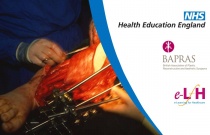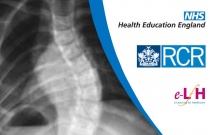Radiological Assessment of Women with Breast Implants
Penny Moyle and Sue Barter
0.50 Hours
This session will help you to understand the various types of breast implants and their complications. It also covers the methods and challenges of radiological assessment of women with implants.
Buttock Flaps for Breast Reconstruction
Anais Rosich-Medina and Elaine Sassoon
0.50 Hours
This session provides a comprehensive account of buttock flaps, their anatomical basis, the steps taken to raise them and their advantages and disadvantages.
Capsular Contracture Around Breast Implants
Saif Ramman and Pari-Naz Mohanna
0.50 Hours
This session provides a detailed account of the pathophysiology of the capsule that forms around breast implants and a review of the current theories about the aetiology of capsular contracture and the principles of management.
Applied Anatomy of the Popliteal Fossa
Samuel Ebbs and Anindya Lahir
0.50 Hours
This session will provide a detailed description of the anatomy of the popliteal fossa and explain why an understanding of the anatomy of this area is important to the plastic surgeon.
Salvage Surgery for Severe Lower Limb Trauma
Denise Osei-Kuffour and Ahid Abood
0.50 Hours
This session will describe how to perform a systematic assessment of viable tissues in patients with severe lower limb trauma. Later, it will explain the advantages of salvage surgery over amputation and explore how to preserve viable tissue for salvage surgery.
Organ Trauma: Blunt Abdominal Trauma
Mansoor A Khan
0.50 Hours
This session will provide an overview of the management of blunt abdominal trauma.
Organ Trauma: Penetrating Abdominal Trauma
Mansoor A Khan
0.50 Hours
This session will provide an overview of the management of penetrating abdominal trauma.
Organ Trauma Vascular Extrinsic Trauma
Morgan P. McMonagle
0.50 Hours
This session describes the types of peripheral vascular injuries that may be encountered, the hard signs of vascular injury and the best approach for management.
CXR: Reticular Patterns (Differential)
Jonathan Benham
0.50 Hours
This session describes the common causes of linear or reticular patterns on chest radiographs (CXR).
Anterior Mediastinal Masses
John Reynolds
0.50 Hours
This session begins with a brief review of some key points of anatomy relating to the mediastinum on the chest radiograph (CXR). Following this is an overview of the radiological appearances (plain film and cross-sectional).
Percutaneous Biliary Intervention
Ian Zealley
0.75 Hours
This session explains percutaneous biliary drainage and other biliary interventional procedures.
Painless Scoliosis
Sylvia Connolly
0.50 Hours
This session explores the features and particularities of painless scoliosis.
Prescribing Safely in Pregnancy
Charlotte Frise
0.50 Hours
This session will focus on prescribing in pregnancy, and the important issues to consider when counselling a pregnant or potentially pregnant woman about this. These include risk/benefit analysis for medications for the treatment of chronic medical conditions, as well as errors of omission for acute medical problems encountered....
CEACCP: Communication skills in critical care
Rupert Gauntlett FRCA EDIC and David Laws FRCA
0.50 Hours
Doctors with poor communication skills are unlikely to achieve success and are more likely to face complaints and litigation.1 Although developments in the drugs and technology of critical care receive close attention, best practice in non-technical skills is relatively neglected; this is despite the fact that attention to this....
Preconception Care
Therese Chapman and Philippa Cox
0.50 Hours
This session will introduce you to the concepts of preconception care, including opportunities for preconception care to be undertaken, and provide you with scenarios to work through to hone your skills in this area.
Patient Pathway in Pencil Beam Scanning
Hazel Pennington, Kevin Sullivan and Laura Allington
0.75 Hours
This session examines the typical patient pathway in a NHS proton beam centre using pencil beam scanning (PBS) technology. It explores the multi-disciplinary teams (MDTs) involved and the important roles they play in the patient pathway.
AI-Powered Early Warning System to Improve Patient Safety
Vibin Roy, MD, MBA and Shelley Chang, MD, PhD
1.00 Hours
Early detection of physiologic deterioration in order to reduce in-hospital mortality and prevent unplanned transfers to the intensive care unit (ICU) is a National Patient Safety Goal. Utility of non-automated early warnings system (MEWS) and Rapid Response Teams (RRT) to reduce in-hospital mortality are often limited due to in....
Create a Data-Driven Process to Manage the Quadruple Aim
Angie Massey and Paul J. Lampi, MHA
1.00 Hours
Join the Memorial Hermann Healthcare Analytics team as we describe our process for creating an environment to conquer the Quadruple Aim. In order to be successful in the population health arena, organizations must meet objectives as outlined by the Institute of Health to improve the patient’s experience of care, improve the hea....
Building Capacity Through Diversity in Health IT Education
Rachelle Blake, MHA, PA
1.00 Hours
Discover how you can help your organization develop, strengthen and diversify its health IT workforce through inclusionary practices, interdisciplinary skill assessment and building, and continuous educational analysis/improvement processes. Based on a HIMSS African-American SIG survey conducted in 2017, health IT professionals....
Webinar - Renal Quality Programs
Avon-Maree Reynolds
Good outcomes can be achieved in the management of Peritoneal Dialysis (PD) patients through continuous quality improvement. Regular audits, data collection and reviews of practice should be a priority in PD units to ensure best practice targets are met.
Elder Abuse
Deb Shearman
1.00 Hours
Overview; Types and signs of elder abuse; Risk factors and protective factors; Compulsory reporting of reportable assaults.
Customer Service
Ms Deb Shearman
0.50 Hours
Overview; Customer service, brand and consumer directed care delivery; good and poor customer service; responding to individual’s needs; Barriers to and effective communication skills Sensitive and courteous handling of complaints and feedback; continuous improvement.
Communication Skills
Jude Chukwuma
0.50 Hours
This session covers the basic principles of good communication and examines some of the common communication errors that may arise during a doctor´s interaction with both patients and colleagues.
Physical Health Care for People With Severe Mental Illness
Jay Bowden
0.50 Hours
Patients with severe mental illness (SMI) have significantly worse health outcomes than in the general population, with life expectancy reduced by up to 20 years in this group. Cardiovascular and metabolic causes have been identified as being the key contributors to this excess mortality and morbidity. This session will explore....
Recognising Your Own Limitations in Symptom Management in Palliative Care
Sarah Wilcox
0.50 Hours
This session discusses how being aware of your own skills and limitations can improve symptom management and care for patients at the end of life. This session was reviewed by Sarah Wilcox and Christina Faull and last updated in January 2017.






















